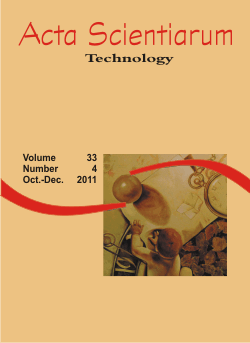<b>Anticoagulant activity of sulfated polysaccharides fractions from an aqueous extract obtained from the red seaweed <em>Halymenia floresia</em> (Clemente) C. Agardh</b> - doi: 10.4025/actascitechnol.v33i4.9143
DOI:
https://doi.org/10.4025/actascitechnol.v33i4.9143Palavras-chave:
marine alga, sulfated macromolecules, purification, physical-chemical characterization, blood coagulationResumo
Heparin (HEP) is known due to their side effects and the red seaweed Halymenia floresia (Hf) sulfated polysaccharides (SP) are heparinoids. In this study we purified the Hf-SP obtained from an aqueous extract and evaluated their anticoagulant activities. Hf-SP1 (25°C), Hf-SP2 (80°C) and Hf-SP3 (80°C) were sequentially isolated. Hf-SP3 had the highest sulfate content (37.45%). Hf-SP3 was fractionated by ion exchange chromatography on a DEAE-cellulose column using a NaCl gradient. Fractions were lyophilized and submitted to 0.5% agarose gel electrophoresis. The anticoagulant activity was evaluated by the activated partial thromboplastin time using rabbits plasma and expressed in international units per mg of SP using standard HEP (193 IU mg-1). The chromatographic procedure separated into four different SP fractions (F I, F II, F III and F IV) eluted at concentrations of 0.50, 0.75, 1.00 and 1.25 M of NaCl, respectively, reveling among them different marked on charge density, when compared by electrophoresis. F III had the highest anticoagulant activity (10.72 IU mg-1), suggesting that the sulfate is important in this process. In conclusion, our results suggest that sequential extractions of Hf-SP are an important biotechnological tool for identification of novel anticoagulants and studies of structural characterization are already in progress.Downloads
Downloads
Publicado
Como Citar
Edição
Seção
Licença
DECLARAÇíO DE ORIGINALIDADE E DIREITOS AUTORAIS
Declaro que o presente artigo é original, não tendo sido submetido í publicação em qualquer outro periódico nacional ou internacional, quer seja em parte ou em sua totalidade.
Os direitos autorais pertencem exclusivamente aos autores. Os direitos de licenciamento utilizados pelo periódico é a licença Creative Commons Attribution 4.0 (CC BY 4.0): são permitidos o compartilhamento (cópia e distribuição do material em qualqer meio ou formato) e adaptação (remix, transformação e criação de material a partir do conteúdo assim licenciado para quaisquer fins, inclusive comerciais.
Recomenda-se a leitura desse link para maiores informações sobre o tema: fornecimento de créditos e referências de forma correta, entre outros detalhes cruciais para uso adequado do material licenciado.















